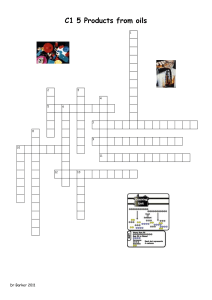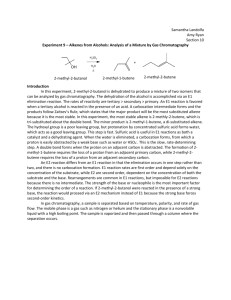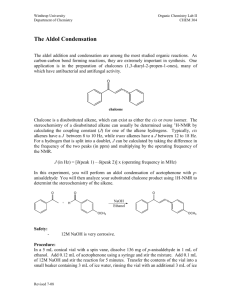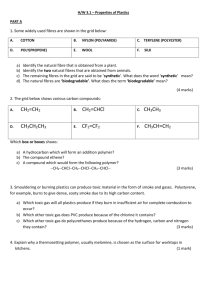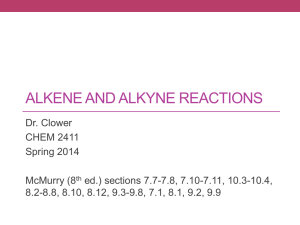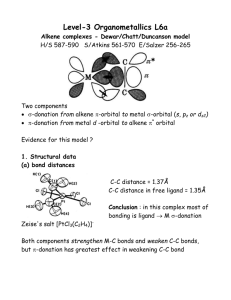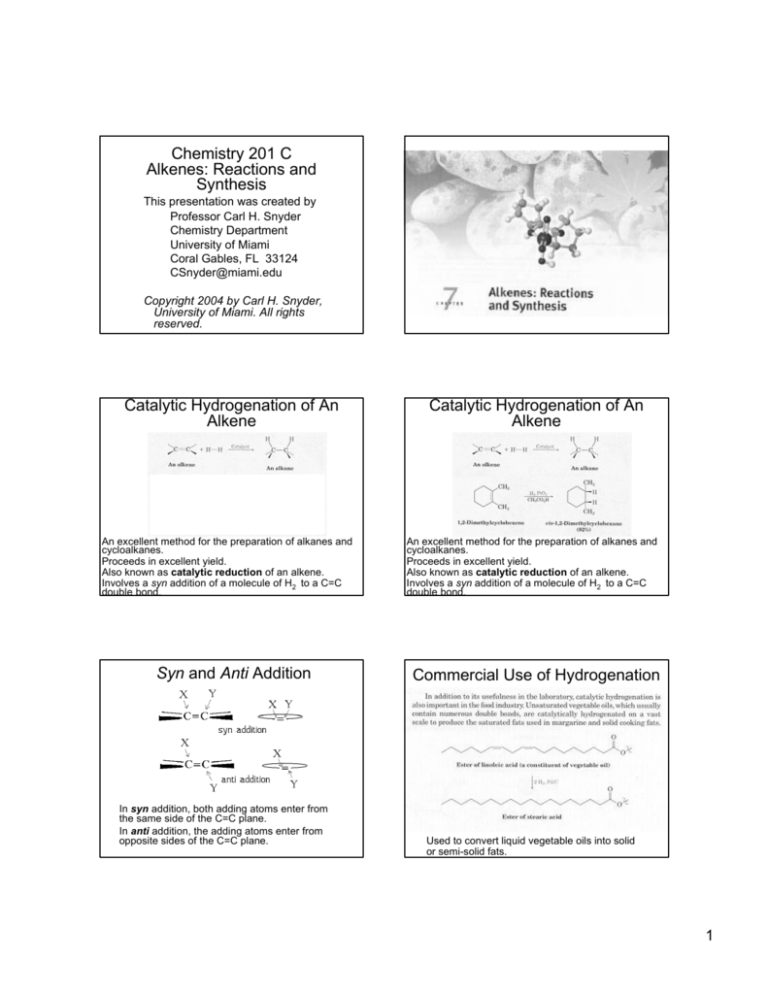
Chemistry 201 C
Alkenes: Reactions and
Synthesis
This presentation was created by
Professor Carl H. Snyder
Chemistry Department
University of Miami
Coral Gables, FL 33124
CSnyder@miami.edu
Copyright 2004 by Carl H. Snyder,
University of Miami. All rights
reserved.
Catalytic Hydrogenation of An
Alkene
An excellent method for the preparation of alkanes and
cycloalkanes.
Proceeds in excellent yield.
Also known as catalytic reduction of an alkene.
Involves a syn addition of a molecule of H2 to a C=C
double bond.
Syn and Anti Addition
In syn addition, both adding atoms enter from
the same side of the C=C plane.
In anti addition, the adding atoms enter from
opposite sides of the C=C plane.
Catalytic Hydrogenation of An
Alkene
An excellent method for the preparation of alkanes and
cycloalkanes.
Proceeds in excellent yield.
Also known as catalytic reduction of an alkene.
Involves a syn addition of a molecule of H2 to a C=C
double bond.
Commercial Use of Hydrogenation
Used to convert liquid vegetable oils into solid
or semi-solid fats.
1
Addition of X2 To C=C
Anti Addition of X2
The mode of addition of X2 to C=C is exclusively anti.
Mechanism: Bromonium Ion
Mechanism: Anti Addition
. . . the anti addition.
The mechanism involves the formation of a
bromonium ion as an intermediate, which
explains . . .
Halohydrin Formation
The Bromonium Ion
Again
If H2O is in high
concentration, the
H2O preempts Brin attacking the
ring-carbon.
The product is a
halohydrin.
Halohydrin formation - The addition of HO-X
to a C=C double-bond.
Halohydrins bear X- and -OH on neighboring
carbons
2
Bromonium Ion Formation
Attack By Water Molecule
Deprotonation
NBS And DMSO
NBS - N-bromosuccinimide, a source of Br2
DMSO - dimethyl sulfoxide, a highly polar solvent.
Alkene Hydration - Acid
Catalysis
Alkene Hydration - Acid
Catalyzed Addition of H2O
Three-step mechanism:
1) Addition of H+ to form carbocation (therefore follows
Markovnikov regioselectivity).
2) Attack by H2O on carbocation
3) Loss of H+ from protonated alcohol.
Water adds to the C=C double bond under acidic
conditions.
3
Mechanism of Acid-Catalyzed
Alkene Hydration
Mechanism of Acid-Catalyzed
Alkene Hydration
Mechanism of Acid-Catalyzed
Alkene Hydration
Mechanism of Acid-Catalyzed
Alkene Hydration
Removal of a proton
Alkene Hydration Oxymercuration
Oxymercuration Mechanism
Another 3-membered ring
Another regioselective
Markovnikov reaction.
No carbocation is formed.
Hg(OAc)2 - mercuric acetate
THF - tetrahydrofuran
NaBH4 - sodium borohydride
4
Oxymercuration Mechanism
Oxymercuration Mechanism
Oxymercuration Mechanism
Oxymercuration Mechanism
Cyclopropanes via Carbenes
Orbital Structure of A Carbene
Addition of a carbene to a C=C double bond
produces a cyclopropane ring.
Another example of 3-membered ring formation
in additions to C=C
Carbon is sp2 hybridized.
The p orbital is empty
One sp2 orbital does not overlap with the bonding
orbital of another atom.
5
Carbene Formation
Three
electronegative Cl’s
polarize the C-H
bonding electrons
toward the C.
The H becomes
slightly acidic.
Removal of H+ by
base, then loss of
Cl- produces Cl2C:,
dichlorocarbene.
Cyclopropane Syntheses
Cyclopropane Syntheses
Cyclopropane Hydrocarbon
Name?
name?
The (iodomethyl)zinc iodide behaves very much
like a carbene.
Cyclopropane Hydrocarbon
Three-Membered Rings in
Intermediates and in Products:
A Review and Summary
Three-membered rings are formed in:
Halogenation of C=C
Halohydrin formation
Oxymercuration
Additions of carbenes to C=C
The (iodomethyl)zinc iodide behaves very much
like a carbene.
6
Hydration via HydroborationOxidation: Borane and Diborane
Hydration via HydroborationOxidation: Hydroboration
In the gaseous state, BH3, borane, exists as a
dimer, B2H6, diborane.
In solution in THF, BH3 exists as a monomer in a
complex with THF.
The B-H bond adds to C=C
Normally, the remaining B-H bonds continue to
add to additional alkene molecules, producing
R3B.
Hydration via HydroborationOxidation: Hydroboration of
Ethylene
The three B-H bonds of one BH3 usually add to
three C=C groups.
The product is a trialkylborane.
(This is not shown in the textbook.)
Hydration via HydroborationOxidation: anti-Markovnikov
syn-Addition
Hydration via HydroborationOxidation: Cyclohexene to
Cyclohexanol
Oxidation occurs by a reaction of the
trialkylborane with alkaline hydrogen
peroxide.
Hydroboration: A 4-Center, synAddition
Trans-2-Methylcyclopentane must be the product of an
anti-Markovnikov, syn-addition to the C=C group.
Note: Here, a syn addition produces a trans product.
7
Hydroboration: An antiMarkovnikov Addition
Note that the B adds to the less highly aklylated C,
and the H adds to the more highly alkylated C.
Hydroboration: Steric Effects
Steric crowding, especially for R2B-H
addition, leads to anti-Markovnikov
regioselectivity.
Hydration of Alkenes: A
Review and Summary
Hydroboration: Steric Effects
large, when R2B -
Steric crowding, especially for R2B-H
addition, leads to anti-Markovnikov
regioselectivity.
Acid-catalyzed hydration: carbocation
intermediate; Markovnikov
regioselectivity
Oxymercuration; no carbocation formed;
Markovnikov regioselectivity
Hydroboration-oxidation; no carbocation;
anti-Markovnikov syn-addition
Alkene Hydroxylation
Polyethylene, A Polymer
CH2=CH2 + CH2=CH2 --->
-CH2-CH2-CH2-CH2-
Hydroxylation leads to glycol or 1,2-diol formation.
OsO4 is osmium tetroxide.
NaHSO3 is sodium hydrogen sulfite.
syn-Addition
5-Membered ring formed as intermediate
-CH2-CH2-CH2-CH2- + CH2=CH2 --->
-CH2-CH2-CH2-CH2- CH2-CH2etc.
8
Polyethylene, A Polymer
n CH2=CH2 ---> -(-CH2-CH2-)-n
Free-Radical Polymerization:
Initiation
Polymerizations
Types of Polymerizations:
Free radical
Cationic
(Anionic)
Mechanistic Steps:
Initiation
Propagation
Termination
Free-radical Polymerization:
Propagation
The polymeric chain grows as the reacton is
repeated, over and over, with additional
ethylene molecules.
In theory , only one benzoyl peroxide molecule
need undergo this homolytic decomposition.
Free-Radical Polymerization:
Termination
Cationic Polymerization
Ends the polymerization before all of the alkene
has been converted to a polymer.
Initiation and propagation occur by electrophilic
addition to C=C double bonds.
9
Other Commercial Polymers
Polypropylene:
synthetic fibers
for rope,
carpeting and
non-clothing
fabrics
Polystyrene:
plastic furniture,
insulating cups;
packaging
nuggets
Rubber, A Naturally Occurring
Polymer
More Appripriate Symbolism
Polypropylene
CH3
|
-(-CH2-CH-)n-
Similarly for polystyrene
Rubber, A Naturally Occurring
Polymer
Rubber is a polymer of 2-methyl-1,3butadiene, known more commonly as
isoprene.
CH2=C-CH=CH2
|
CH3
Rubber, A Naturally Occurring
Polymer
Natural rubber is a polymer of 2-methyl-1,3butadiene.
The geometry of the C=C double bonds of
natural rubber is . . .
Other Important Polymers
Polymer
Monomer
cellulose
glucose
starch
glucose
teflon
CF2=CF2
PVC, poly(vinyl chloride) CH2=CHCl
Natural rubber is a polymer of 2-methyl-1,3butadiene.
The geometry of the C=C double bonds of
natural rubber is . . .
10
End
Alkenes: Reactions and Synthesis
11

